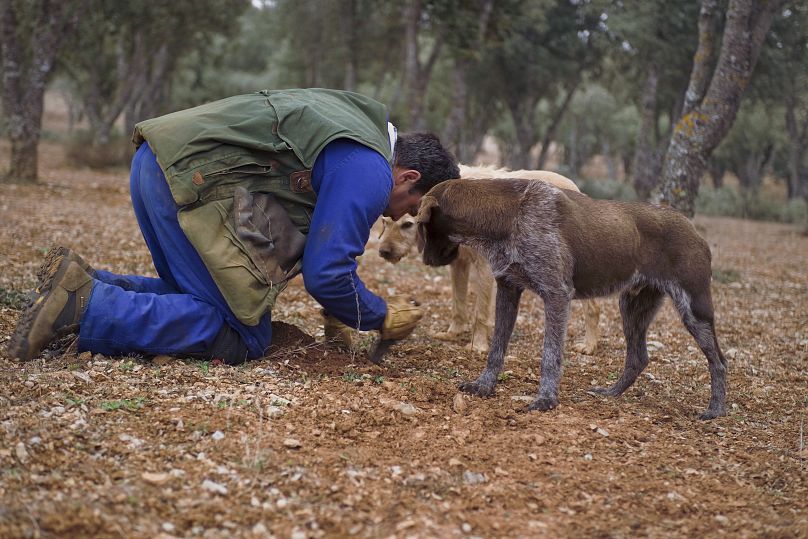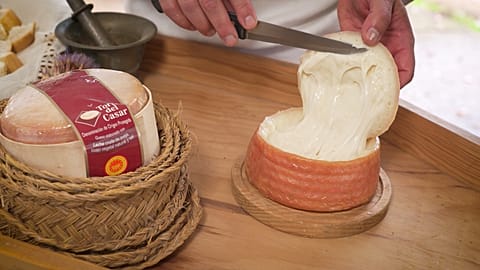Spain is rich in black truffles. Most of the production can be found in the northeastern Girona forest and central Teruel. Not only is there an abundance of these aromatic treasures to be found in the country, but Spain is also the world’s biggest producer of black winter truffles.
Spain is rich in black truffles. Most of the production can be found in the northeastern Girona forest and central Teruel. Not only is there an abundance of these aromatic treasures to be found in the country, but Spain is also the world’s biggest producer of Tuber melanosporum (black winter truffles).
Known as black gold or black diamonds, Tuber melanosporum are sought-after by chefs worldwide. They also grow in France and Italy but Spain is the world’s leading black truffles producer.
Spain also grows the black summer truffle, Tuber aestivum. Though traditionally grown and harvested in the wild, truffles can be farmed too, however, it’s hardly a straightforward process.
So why is Spanish soil so good at growing these elusive fungi?
What are black truffles?
Truffles are subterranean fungi that grow near the roots of certain types of trees, such as oak, holm oak and hazelnut. While the truffles themselves do not touch the roots of the trees, they are connected to them via a huge network of mycelium (a root-like web of fungus strands), which stretch for kilometres under the soil. The trees and the truffles have a symbiotic relationship, sharing nutrients and water.
Truffles are the fruit of this mycelium network and can be found around 20 centimetres deep underground. This is why dogs with a good sense of smell are used to sniff them out and extract them from the earth.
Black and white truffles have been prized for their culinary value for thousands of years. While there are many species of truffle, not all of them are edible and some are more prized than others.
Why are black truffles so special?
“Truffles are flavour enhancers like no other, they have brought to the world of cooking endless new flavours that otherwise would have never existed,” says Sofia Agustin from Manjares de la Tierra, a company in Sarrión, Teruel.
“Truffles have a flavour so particular that it cannot be compared to anything else. They can have over 48 distinct nuances, such as butter, caramel, wood, wet soil, hay and ground coffee,” she continues.
The black winter truffle season in Sarrión is from November to April. Chefs admire the unique, earthy aroma of the black winter truffle which is more subtle than the flavour found in white truffles. Tuber melanosporum can be cooked into sauces as well as eaten raw.
Meanwhile, and as the name suggests, black summer truffles can be found from May to September. With a more delicate aroma than their winter sibling, they are less rare, making them an ideal truffle for beginners. They can be found growing in the wild in the Spanish regions of Catalonia and Guadalajara.
Where do black truffles grow in Spain?
The north-eastern region of Aragon is the heartland of Spain’s black winter truffle market. Around 60 per cent of the country’s black truffles are grown here. Production is split between the provinces of Teruel, Huesca and Zaragoza, with the majority of truffles farmed in the rugged, high-altitude province of Teruel.
Farming black truffles isn’t as easy as farming other fungi though.
“From the first inoculated trees planted until the first grown truffles, farmers have to overcome up to 10 years of no benefit or harvest,” says Agustin.
The long wait time is only half the battle though, as there are strict instructions to maintain the truffle fields. While the fields “simulate the natural conditions of the forest”, the environment can be controlled, explains Agustin.
“For example, using micro-spraying irrigation systems we achieve an equitable distribution of water that simulates fine rain when needed.”
Temperature and climate are also very important for truffle growth, which is why Teruel is the ideal location for them.
“Here, 900 to 1,200 metres above sea level, we have the ideal climate, and we are protected from strong winds by being located amidst two mountains. This makes our limestone lands just perfect for the truffle to grow safely,” says Augustin.
In the wild, black truffles can be found in the Catalan forest of Girona, where they are hunted by local truffle hunters and sellers between November and March. Though special truffle hunting hounds are bought and sold for high prices, Agustin explains that it’s not all about the pedigree of the dog.
“It is not as relevant as some believe. What’s relevant is that they have a good sense of smell and a predisposition to learning; for example, a bulldog would not be a good candidate for this job since their olfactory skills are diminished. But a street dog with a good nose and a desire to learn could be your companion until the end of his days.”
Abejar Black Truffle Festival
The remaining 40 per cent of Spain’s truffles can be found in other eastern regions, such as Catalonia and Castile-León. The province of Soria in north-central Spain is a great place to visit to sample some of the truffles the area has to offer.
The annual Black Truffle Festival takes place every February in the town of Abejar, and is a celebration of all things truffle. Expect markets, workshops and local restaurants offering special truffle menus, something which Pedro Marco Montori, head researcher at the Center for Research and Agrifood Technology of Aragon (CITA), recommends.
“The truffle is an aroma factory while it is alive or breathes, and those molecules that it gives off can be used to truffle other foods,” he said.
“The great chefs are aware of this secret, offering diners complete truffle menus with just a few grams of truffle.”

